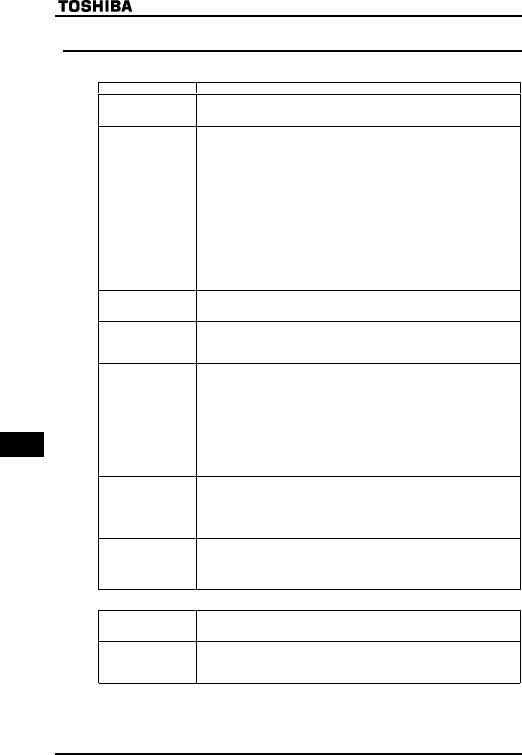
E6581090
M-8
13
13.4 How to determine the causes of other problems
The following table provides a listing of other problems, their possible causes and remedies.
Problems Causes and remedies
The motor runs in
the wron
g
direction.
• Invert the phases of the output terminals U, V and W.
• Invert the forward/reverse run-signal terminals of the external input
device. (See 6.2 "Assignment of functions to control terminals".)
The motor runs but
its speed does not
change normally.
• The load is too heavy.
Reduce the load.
• The soft stall function is activated.
Disable the soft stall function. (See 5.10.)
• The maximum frequency HJ and the upper limit frequency WN are set
too low.
Increase the maximum frequency HJ and the upper limit frequency
WN.
• The frequency setting signal is too low.
Check the signal set value, circuit, cables, etc.
• Check the setting characteristics (point 1 and point 2 settings) of the
frequency setting signal parameters. (See 6.4.)
• If the motor runs at a low speed, check to see that the stall prevention
function is activated because the torque boost amount is too large.
Ad
j
ust the torque boost amount
(
XD
)
and the acceleration time
(
CEE
)
.
(See 5.1.)
The motor does not
accelerate or
decelerate smoothl
y
.
• The acceleration time (CEE) or the deceleration time (FGE) is set too
short.
Increase the acceleration time
(
CEE
)
or the deceleration time
(
FGE
)
.
A too large current
flows into the motor.
• The load is too heavy.
Reduce the load.
• If the motor runs at a low speed, check whether the torque boost amount
is too large. (See 5.9.)
The motor runs at a
higher or lower
speed than the
specified one.
• The motor has an improper voltage rating.
Use a motor with a proper voltage rating.
• The motor terminal voltage is too low.
Check the setting of the base frequency voltage parameter (H).
(See 6.12.)
Replace the cable with a cable larger in diameter.
• The reduction gear ratio, etc., are not set properly.
Adjust the reduction gear ratio, etc.
• The output frequency is not set correctly.
Check the output frequency range.
• Adjust the base frequency. (See 5.8.)
The motor speed
fluctuates during
operation.
• The load is too heavy or too light.
Reduce the load fluctuation.
• The inverter or motor used does not have a rating large enough to drive
the load.
Use an inverter or motor with a rating large enough.
• Check whether the frequency setting signal changes.
Parameter settings
cannot be chan
g
ed.
Change the setting of the parameter H (prohibition of change of
parameter setting) to .. (permitted) if it is set at ...
(prohibited).
*For safety’s sake, some parameters cannot be set during operation.
(See 4.1.4.)
How to cope with parameter setting-related problems
If you forget
parameters which
have been reset
You can search for all reset parameters and change their settings.
*Refer to 4.1.3 for details.
If you want to return
all reset parameters
to their respective
default settings
You can return all parameters which have been reset to their default
settings.
*Refer to 4.1.5 for details.


















